GMF’s Municipal Energy Roadmap gives elected officials and municipal staff a framework to identify and design innovative sustainable energy projects. The support tool helps you identify the best solutions for Canadian communities to achieve significant GHG emissions reductions and meet your long-term sustainability objectives.
These fifteen factsheets offer specific guidance around building-level solutions, community-level solutions, and long-term strategies to achieve your goals. Whether you want to discover financing options to adopt sustainable energy technologies or implement specific solutions like low-carbon water heating, these resources provide targeted insights to help you drill down and meet your objectives.
Strategy: Local development policies and bylaws
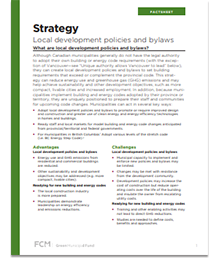 Although Canadian municipalities generally do not have the legal authority to adopt their own building or energy code, they can create local development policies and bylaws to set building requirements that exceed or complement the provincial code. Find out more.
Although Canadian municipalities generally do not have the legal authority to adopt their own building or energy code, they can create local development policies and bylaws to set building requirements that exceed or complement the provincial code. Find out more.
Strategy: Financing options
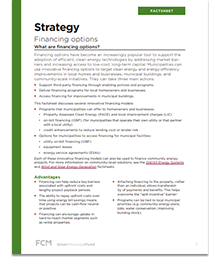 Discover how municipalities can use innovative financing options to target clean energy and energy-efficiency improvements in local homes and businesses, municipal buildings, and community-scale initiatives.
Discover how municipalities can use innovative financing options to target clean energy and energy-efficiency improvements in local homes and businesses, municipal buildings, and community-scale initiatives.
Strategy: Home/building energy rating and disclosure
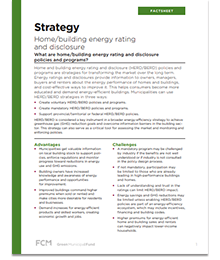 Read about how municipalities can use home and building energy rating and disclosure (HERD/BERD) policies and programs as strategies for transforming the market over the long term.
Read about how municipalities can use home and building energy rating and disclosure (HERD/BERD) policies and programs as strategies for transforming the market over the long term.
Strategy: Incentive programs
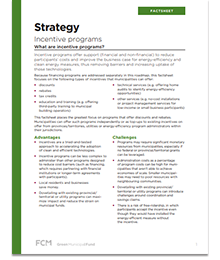 Learn how incentive programs offer support to reduce participants’ costs and improve the business case for energy-efficiency and clean energy measures, thus removing barriers and increasing uptake of those technologies.
Learn how incentive programs offer support to reduce participants’ costs and improve the business case for energy-efficiency and clean energy measures, thus removing barriers and increasing uptake of those technologies.
Strategy: Lead by example
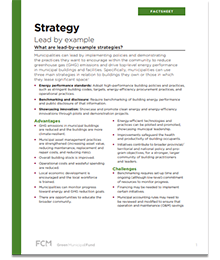 Municipalities can lead by implementing policies and demonstrating the practices they want to encourage within the community to reduce greenhouse gas (GHG) emissions and drive top-level energy performance in municipal buildings and facilities. Find out how.
Municipalities can lead by implementing policies and demonstrating the practices they want to encourage within the community to reduce greenhouse gas (GHG) emissions and drive top-level energy performance in municipal buildings and facilities. Find out how.
Community-level solution: District energy systems
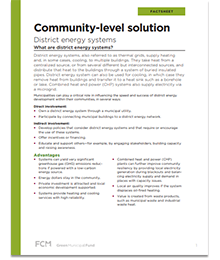 District energy systems, also referred to as thermal grids, supply heating and, in some cases, cooling, to multiple buildings. Learn how municipalities can play a critical role in influencing the speed and success of district energy development within their communities.
District energy systems, also referred to as thermal grids, supply heating and, in some cases, cooling, to multiple buildings. Learn how municipalities can play a critical role in influencing the speed and success of district energy development within their communities.
Community-level solution: Wind and solar energy generation
 Discover the advantages of community-level wind and solar energy generation: local economic development, community resiliency, reduced GHGs, and energy dollars staying in the community.
Discover the advantages of community-level wind and solar energy generation: local economic development, community resiliency, reduced GHGs, and energy dollars staying in the community.
Building-level solution: High-efficiency indoor ice rinks
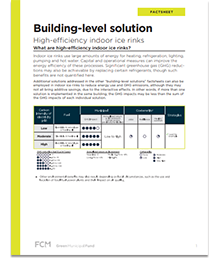 Indoor ice rinks use large amounts of energy for heating, refrigeration, lighting, pumping and hot water. Capital and operational measures can improve the energy efficiency of these processes.
Indoor ice rinks use large amounts of energy for heating, refrigeration, lighting, pumping and hot water. Capital and operational measures can improve the energy efficiency of these processes.
Building-level solution: Building envelope upgrades
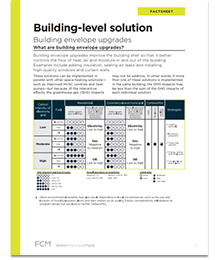 Building envelope upgrades improve the building shell so that it better controls the flow of heat, air and moisture in and out of the building. Find out how to leverage these upgrades for energy efficiency and reduced GHGs.
Building envelope upgrades improve the building shell so that it better controls the flow of heat, air and moisture in and out of the building. Find out how to leverage these upgrades for energy efficiency and reduced GHGs.
Building-level solution: Heat pumps replacing electric resistance
 Heat pumps provide efficient heating by drawing heat from outside air, the ground or a water body, and transferring that heat into a building. Learn more about the use of electric-powered heat pumps in place of electric resistance heating like baseboards, electric furnaces and electric boilers.
Heat pumps provide efficient heating by drawing heat from outside air, the ground or a water body, and transferring that heat into a building. Learn more about the use of electric-powered heat pumps in place of electric resistance heating like baseboards, electric furnaces and electric boilers.
Building-level solution: Heat pumps replacing gas or oil
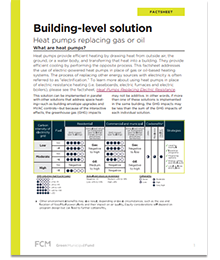 Heat pumps provide efficient heating by drawing heat from outside air, the ground or a water body, and transferring that heat into a building. Learn more about the use of electric-powered heat pumps in place of gas or oil-based heating systems.
Heat pumps provide efficient heating by drawing heat from outside air, the ground or a water body, and transferring that heat into a building. Learn more about the use of electric-powered heat pumps in place of gas or oil-based heating systems.
Building-level solution: Improved HVAC controls
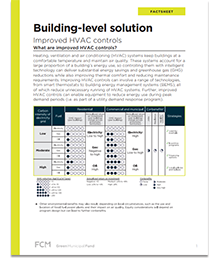 Heating, ventilation and air conditioning account for a large proportion of a building’s energy use. Controlling them with intelligent technology can deliver substantial energy savings and GHG reductions while also improving thermal comfort and reducing maintenance requirements. Learn how.
Heating, ventilation and air conditioning account for a large proportion of a building’s energy use. Controlling them with intelligent technology can deliver substantial energy savings and GHG reductions while also improving thermal comfort and reducing maintenance requirements. Learn how.
Building-level solution: High-efficiency lighting and reduced plug loads
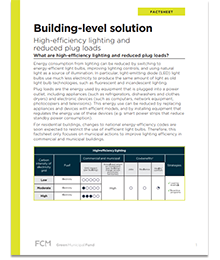 Discover how energy consumption from lighting can be reduced by switching to energy-efficient light bulbs, improving lighting controls, and using natural light as a source of illumination.
Discover how energy consumption from lighting can be reduced by switching to energy-efficient light bulbs, improving lighting controls, and using natural light as a source of illumination.
Building-level solution: Rooftop solar PV
 Solar PV systems are primarily used to reduce utility bills by offsetting the building’s own electricity consumption. Learn how these systems can also be paired with battery storage to provide a number of additional benefits.
Solar PV systems are primarily used to reduce utility bills by offsetting the building’s own electricity consumption. Learn how these systems can also be paired with battery storage to provide a number of additional benefits.
Building-level solution: Low-carbon water heating
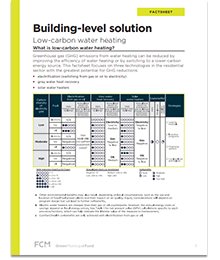 Greenhouse gas emissions from water heating can be reduced by improving the efficiency of water heating or by switching to a lower-carbon energy source. Read about three technologies in the residential sector with the greatest potential for GHG reductions.
Greenhouse gas emissions from water heating can be reduced by improving the efficiency of water heating or by switching to a lower-carbon energy source. Read about three technologies in the residential sector with the greatest potential for GHG reductions.
Available funding
We support projects at various stages of development through grants and loans. Funding amounts are based on total eligible costs. Further details on eligible costs are provided on individual funding pages.
Business case: Community Energy Systems
Funding to assess viable community energy projects and their business models
Read moreStudy: Community Energy Systems
Funding to outline the design of a proposed community energy system
Read moreCapital project: Community Energy Systems
Funding to construct, commission and rapidly deploy a community energy system
Read more
